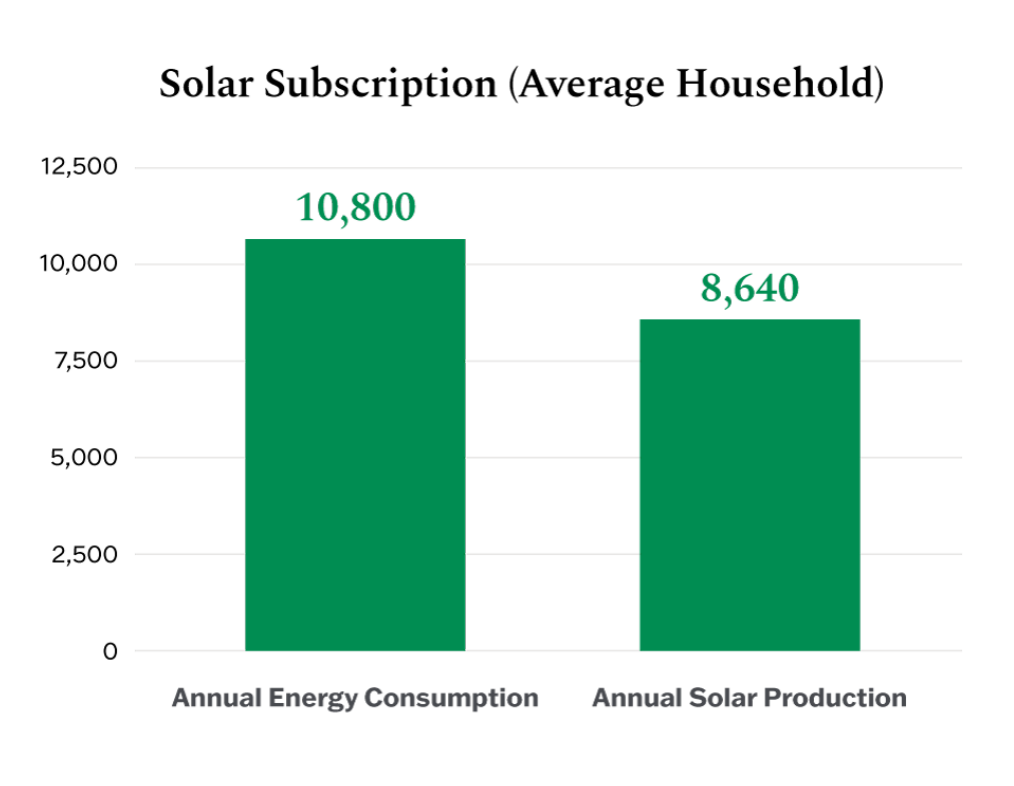Quick Definitions
- Bill Credits: the amount of money credited to your utility account, earned by your solar subscription
- Bill Credit Rate: the monetary value of a kWh (a unit of electricity) which you are credited
- Subscription Fees: monthly fees paid by subscribers to community solar project managers. Fees are always lower than credits for low-income participants.
Credits and fees show up directly on your utility bill from Pacific Power, Portland General Electric, or Idaho Power. No separate bills will arrive from Oregon Community Solar. These fees will be at a fixed rate per unit of energy produced from your subscription for the duration of your contract ($/kWh).
1. How much will this program cost me?
Different projects will charge different fees, but as a low-income subscriber, your subscription fee will always be at least 20% less than your bill credit rate, which results in monthly savings on your electric bill.
The total amount you pay and receive will depend on the size of your solar subscription. Subscription fees and bill credits (money you earn back) are calculated based on how much solar energy you use and subscribe to. We determine your size by looking back at your energy use history in order to make sure your subscription size fits your needs. See Question 3 for more information about how sizing works.
Each utility company has their own bill credit rate and subscription fee rate:
Portland General Electric Pacific Power Idaho Power Use kWh Rate ($/kWh) $0.12 $0.11 $0.10 Bill Credit Rate ($/kWh) $0.11 $0.10 $0.08 Maximum Subscription Fee Rate ($/kWh) $0.09 $0.08 $0.07 Rates are rounded to the nearest cent
Here is one example of a subscription size for a household that has average energy use in Oregon:
In the example below, our subscriber has been assigned a subscription size of 80% of their energy use. Assuming they are a PGE customer, they will pay $775 in subscription fees each year, and receive $967 in bill credits. Total, they save $192 each year.

2. Will my credits and fees be the same every month?
No. These fees and credits will be split throughout the year, depending on how much solar energy is produced each month. In the summer, Oregon sees up to 16 hours of daylight, while in the winter, this drops to around 9 hours. This means that far more energy will be produced in summer months and less during winter months.
The graph below shows how bill credits and subscription fees rise in the Summer, as more solar energy is produced, and drop down again in Winter. However, no matter the time of year, subscription fees remain less than bill credits, meaning the customer sees savings every single month of the year.

3. How is my subscription size decided?
We will use the utility account number and meter number you provided during your intake call to access your energy use history. Your solar subscription will likely be sized at 80% of your average annual energy use. If you do not have at least 6 months history with your utility provider at your current housing location, your solar subscription will be sized more modestly to protect you from oversubscription (See Question 4). You and your project manager have the final say on what size your subscription is. You will be able to review your subscription size, estimated savings and fees before you sign your contract.
4. What is oversubscription?
Any community solar participant is not allowed to have more than 100% of their annual energy use covered by solar, meaning you are not allowed to pay fees and receive benefits on more energy than you actually use. If a subscription size is too large, your project manager will notify you that your size will be reduced to ensure you are no longer oversubscribed. Any amount over your annual energy use will be deducted from your upcoming credits, which may temporarily pause your solar benefits until that oversubscription has been “paid back”. CEP recommends that low-income customers are sized at 80% of annual energy use to avoid the possibility of oversubscription, but you and your PM may decide to go higher or lower. As a final safeguard, our system runs regular checks on all community solar accounts to flag for any account that may be oversubscribed so that we can adjust their sizing accordingly.
We support you.
If you find that you need extra assistance, please contact Community Energy Project, our low-income nonprofit partner.
CommunityEnergyProject.org
Community Solar Coordinator
971-544-8718
971-544-8720 (for Spanish)
[email protected]
